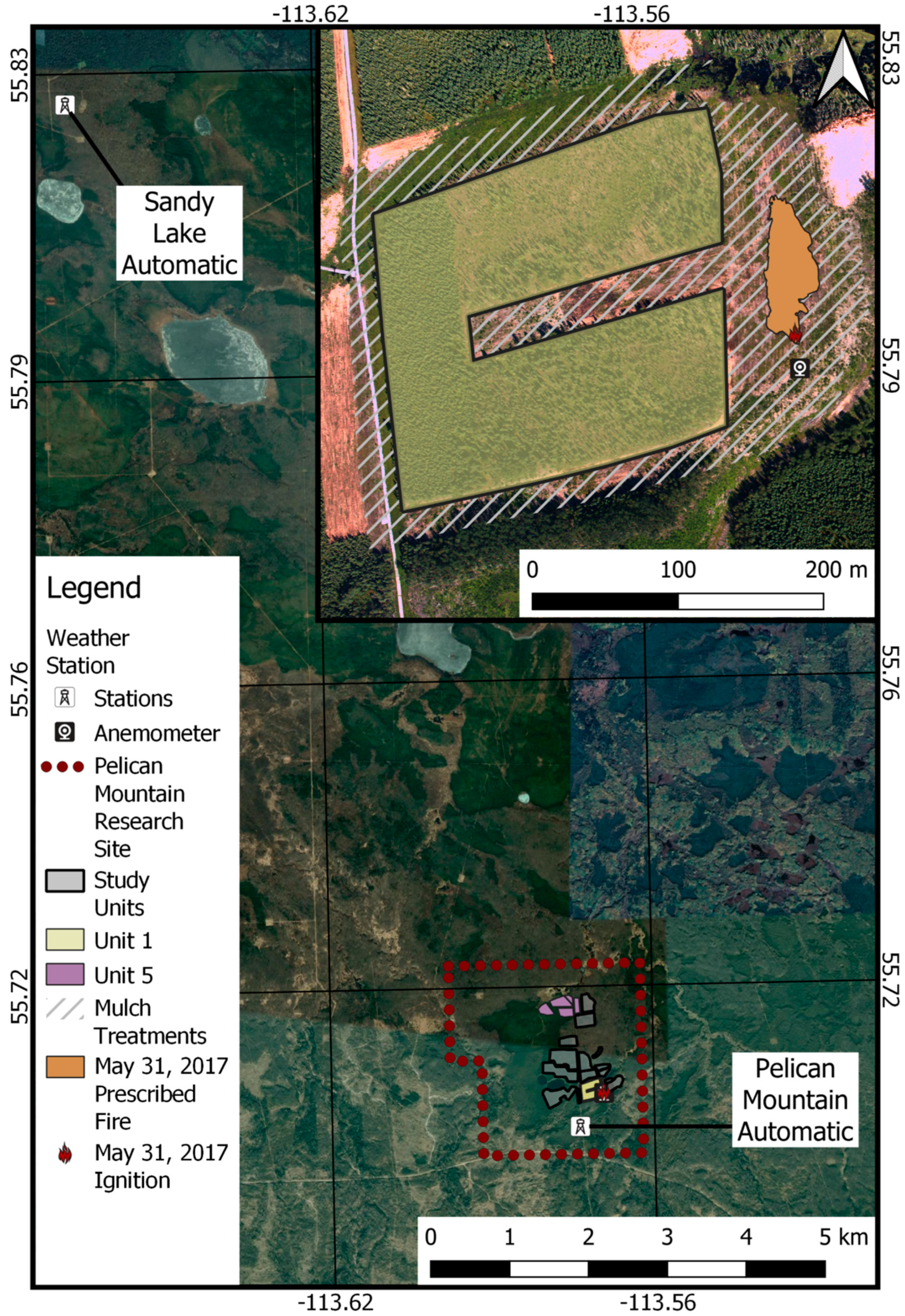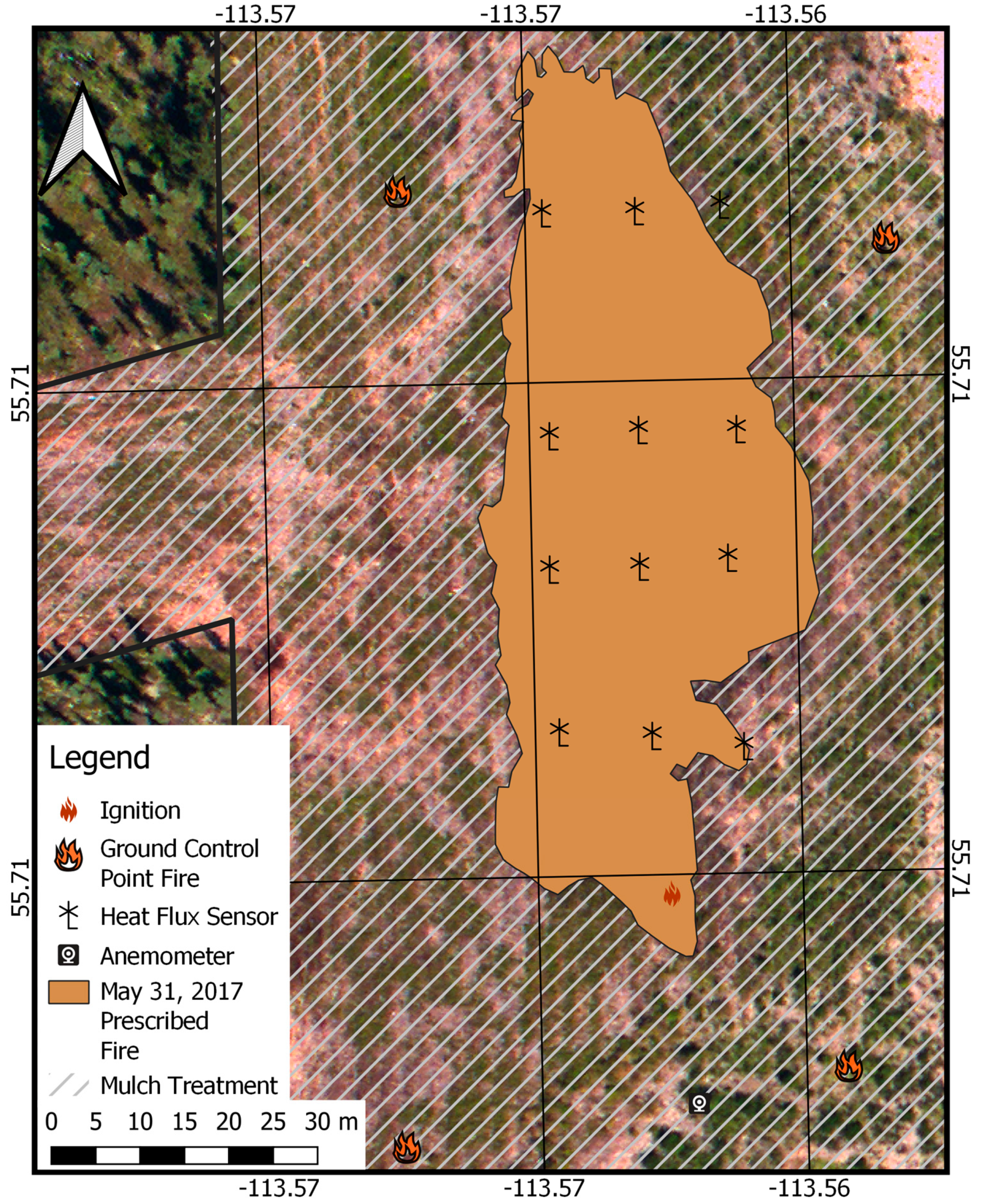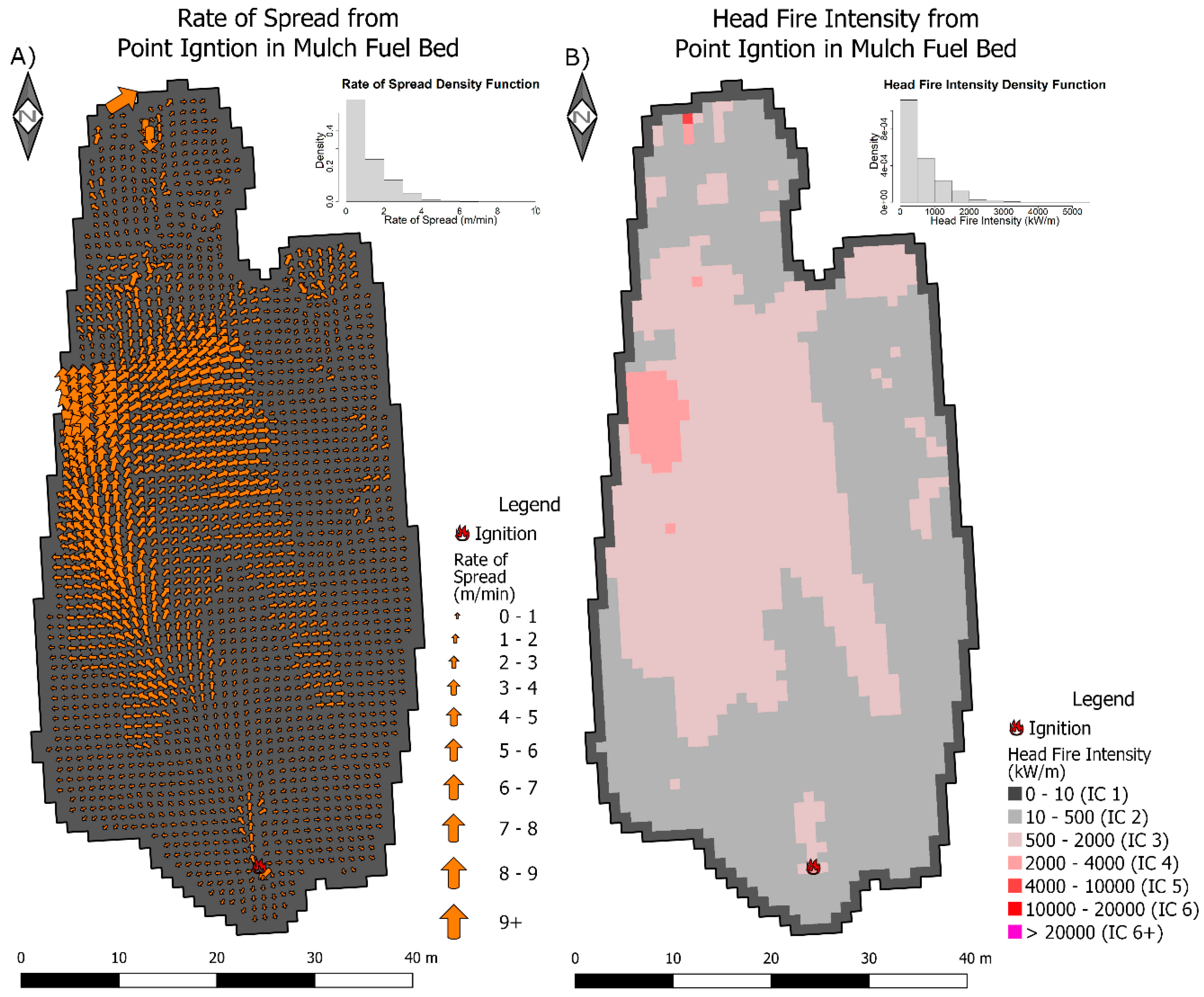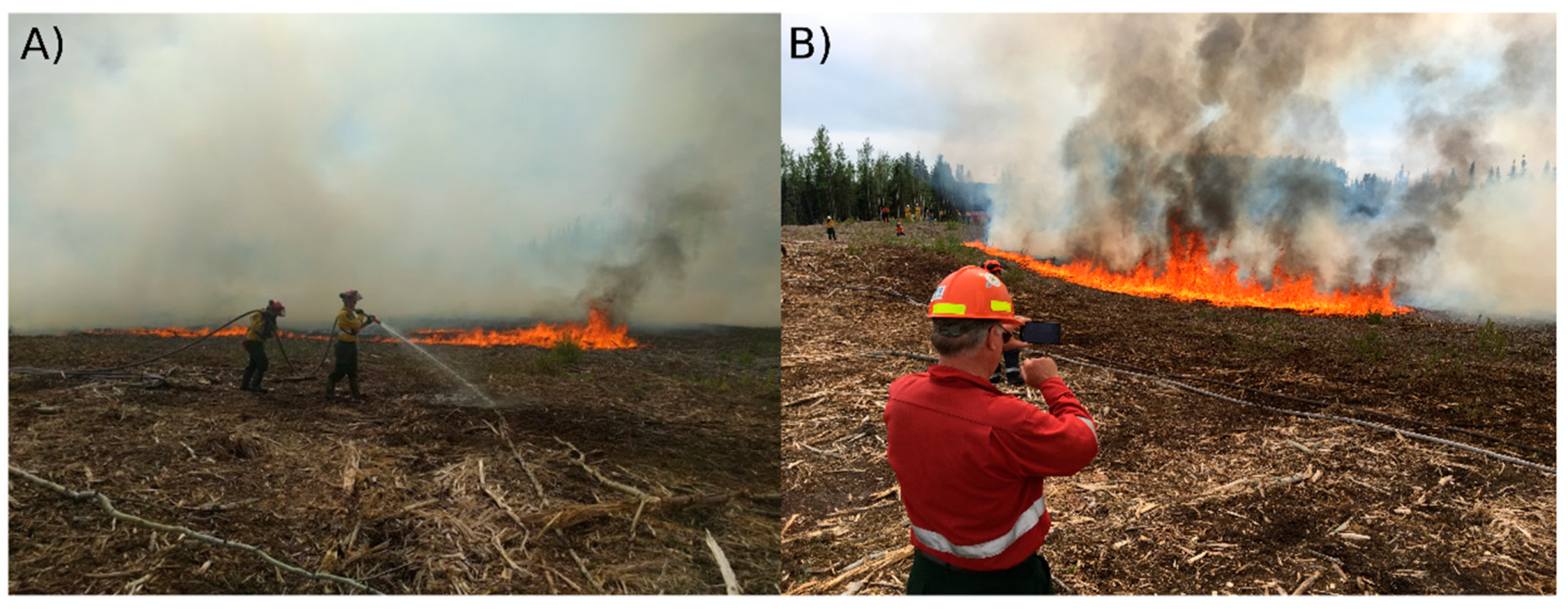Using Infrared Imagery to Assess Fire Behaviour in a Mulched Fuel Bed in Black Spruce Forests
Abstract
:1. Introduction
2. Materials and Methods
2.1. Site Description
2.2. Weather
2.3. Prescribed Fire and Data Collection
3. Results
3.1. Fire Observations
3.2. Comparison to Fire Behaviour Models
4. Discussion
5. Conclusions
Author Contributions
Funding
Acknowledgments
Conflicts of Interest
References
- Keane, R.E. Wildland Fuel Fundamentals and Applications; Springer: Berlin/Heidelberg, Germany, 2014; ISBN 978/3/319/09015/3. [Google Scholar]
- Tymstra, C.; Stocks, B.J.; Cai, X.; Flannigan, M.D. Wildfire management in Canada: Review, challenges and opportunities. Prog. Disaster Sci. 2019, 5, 100045. [Google Scholar] [CrossRef]
- FireSmart Canada. FireSmart: Protecting Your Community from Wildfire, 2nd ed.; Partners in Protection: Edmonton, AB, Canada, 2003; ISBN 978/0/662/34064/5. Available online: https://cfs.nrcan.gc.ca/publications?id=22969 (accessed on 25 May 2020).
- Hvenegaard, S.; Schroeder, D.; Thompson, D.K. Fire Behaviour in Black Spruce Forest Fuels Following Mulch Fuel Treatments: A Case Study at Red Earth Creek, Alberta; FP Innovations Wildfire Operations Research Group: Edmonton, AB, Canada, 2016; p. 29. Available online: https://cfs.nrcan.gc.ca/publications?id=38087 (accessed on 30 May 2020).
- Kreye, J.K.; Brewer, N.W.; Morgan, P.; Varner, J.M.; Smith, A.; Hoffman, C.M.; Ottmar, R.D. Fire behavior in masticated fuels: A review. For. Ecol. Manag. 2014, 314, 193–207. [Google Scholar] [CrossRef]
- Hirsch, K.G. Canadian Forest Fire Behavior Prediction (FBP) System: User’s Guide; Canadian Forestry Service: Edmonton, AB, Canada, 1996; Volume 7, ISBN 978/0/660/16389/5. Available online: https://www.frames.gov/catalog/13302 (accessed on 27 May 2020).
- Whitman, E.; Parisien, M.-A.; Thompson, D.K.; Flannigan, M.D. Short-interval wildfire and drought overwhelm boreal forest resilience. Sci. Rep. 2019, 9, 18796. [Google Scholar] [CrossRef] [PubMed] [Green Version]
- Thompson, D.K.; Schroeder, D.; Wilkinson, S.L.; Barber, Q.; Baxter, G.; Cameron, H.; Hsieh, R.; Marshall, G.; Moore, B.; Refai, R.; et al. Recent Crown Thinning in a Boreal Black Spruce Forest Does Not Reduce Spread Rate nor Total Fuel Consumption: Results from an Experimental Crown Fire in Alberta, Canada. Fire 2020, 3, 28. [Google Scholar] [CrossRef]
- Hvenegaard, S. Mulching Productivity in Black Spruce Fuels: Productivity as a Function of Treatment Intensity; FP Innovations: Edmonton, AB, Canada, 2019; p. 14. [Google Scholar]
- Larsen, C.P.S. Spatial and temporal variations in boreal forest fire frequency in northern Alberta. J. Biogeogr. 1997, 24, 663–673. [Google Scholar] [CrossRef]
- Hanes, C.C.; Wang, X.; Jain, P.; Parisien, M.-A.; Little, J.M.; Flannigan, M.D. Fire-regime changes in Canada over the last half century. Can. J. For. Res. 2018, 49, 256–269. [Google Scholar] [CrossRef]
- Schiks, T.; Thompson, D.K.; Wotton, B.M. Short-term effects of mastication on fuel moisture and thermal regime of boreal fuel beds. Can. J. For. Res. 2015, 45, 867–876. [Google Scholar] [CrossRef]
- Johnston, J.M.; Wheatley, M.J.; Wooster, M.J.; Paugam, R.; Davies, G.M.; DeBoer, K.A. Flame-Front Rate of Spread Estimates for Moderate Scale Experimental Fires Are Strongly Influenced by Measurement Approach. Fire 2018, 1, 16. [Google Scholar] [CrossRef] [Green Version]
- Hijmans, R.J.; Van Etten, J.; Sumner, M.; Cheng, J.; Bevan, A.; Bivand, R.; Busetto, L.; Canty, M.; Forrest, D.; Ghosh, A.; et al. Raster: Geographic Data Analysis and Modeling. 2020. Available online: https://cran.r-project.org/web/packages/raster/raster.pdf (accessed on 20 May 2020).
- Sullivan, E.A.; McDonald, A.G. Mathematical model and sensor development for measuring energy transfer from wildland fires. Int. J. Wildland Fire 2014, 23, 995–1004. [Google Scholar] [CrossRef]
- Thompson, D.K.; Schiks, T.J.; Wotton, B.M. Fuel size impacts on carbon residuals and combustion dynamics in masticated woody debris. For. Ecol. Manag. 2016, 369, 59–65. [Google Scholar] [CrossRef]
- Andrews, P.L. The Rothermel Surface Fire Spread Model and Associated Developments: A Comprehensive Explanation; U.S. Department of Agriculture, Forest Service, Rocky Mountain Research Station: Fort Collins, CO, USA, 2018; p. 121.
- Podur, J.; Wotton, B.M. Defining fire spread event days for fire-growth modelling. Int. J. Wildland Fire 2011, 20, 497–507. [Google Scholar] [CrossRef] [Green Version]
- Little, J.M.; Jandt, R.; Drury, S.A.; Molina, A.; Lane, B. Evaluating the Effectiveness of Fuel Treatments in Alaska; University of Alaska-Fairbanks: Fairbanks, AK, USA, 2018; p. 97. [Google Scholar]
- Wilkinson, S.L.; Moore, P.A.; Thompson, D.K.; Wotton, B.M.; Hvenegaard, S.; Schroeder, D.; Waddington, J.M. The effects of black spruce fuel management on surface fuel condition and peat burn severity in an experimental fire. Can. J. For. Res. 2018, 48, 1433–1440. [Google Scholar] [CrossRef]
- Egley, G.H. High-Temperature Effects on Germination and Survival of Weed Seeds in Soil. Weed Sci. 1990, 38, 429–435. [Google Scholar] [CrossRef]
- Dahlquist, R.M.; Prather, T.S.; Stapleton, J.J. Time and Temperature Requirements for Weed Seed Thermal Death. Weed Sci. 2007, 55, 619–625. [Google Scholar] [CrossRef]
- Lieffers, V.J.; Macdonald, S.E.; Hogg, E.H. Ecology of and control strategies for Calamagrostiscanadensis in boreal forest sites. Can. J. For. Res. 1993, 23, 2070–2077. [Google Scholar] [CrossRef]




| Weather Variable | May 31—Anemometer | May 31—Temporary Automatic | Sandy Lake 30-Year Average |
|---|---|---|---|
| Temperature (°C) [nth percentile] | 28 (99) | 33 (100) | 14 |
| Relative Humidity (%) [nth percentile] | 23 (97) | 37 (63) | 47 |
| Wind Speed (km h−1) [nth percentile] | 10 (47) | 7 (25) | 12 |
| Fire Weather | |||||
|---|---|---|---|---|---|
| FFMC | DMC | BUI | DC | ISI | FWI |
| 93 | 63 | 69 | 175 | 9 | 24 |
| Fire Behaviour | |||
|---|---|---|---|
| Fuel Type | Rate of Spread (m min−1) | Head Fire Intensity (kW m−1) | Fuel Consumption (kg m−2) |
| Observed | |||
| Mulch | 1.2 | 650 | 1.8 |
| Reference Model | |||
| S-1 | 16 | 35,000 | 7 |
| S-2 | 8 | 28,000 | 12 |
| S-3 | 13 | 94,000 | 23 |
| M-2 (50% conifer) | 8 | 5000 | 2.8 |
© 2020 by the authors. Licensee MDPI, Basel, Switzerland. This article is an open access article distributed under the terms and conditions of the Creative Commons Attribution (CC BY) license (http://creativecommons.org/licenses/by/4.0/).
Share and Cite
Moore, B.; Thompson, D.K.; Schroeder, D.; Johnston, J.M.; Hvenegaard, S. Using Infrared Imagery to Assess Fire Behaviour in a Mulched Fuel Bed in Black Spruce Forests. Fire 2020, 3, 37. https://doi.org/10.3390/fire3030037
Moore B, Thompson DK, Schroeder D, Johnston JM, Hvenegaard S. Using Infrared Imagery to Assess Fire Behaviour in a Mulched Fuel Bed in Black Spruce Forests. Fire. 2020; 3(3):37. https://doi.org/10.3390/fire3030037
Chicago/Turabian StyleMoore, Brett, Dan K. Thompson, Dave Schroeder, Joshua M. Johnston, and Steven Hvenegaard. 2020. "Using Infrared Imagery to Assess Fire Behaviour in a Mulched Fuel Bed in Black Spruce Forests" Fire 3, no. 3: 37. https://doi.org/10.3390/fire3030037
APA StyleMoore, B., Thompson, D. K., Schroeder, D., Johnston, J. M., & Hvenegaard, S. (2020). Using Infrared Imagery to Assess Fire Behaviour in a Mulched Fuel Bed in Black Spruce Forests. Fire, 3(3), 37. https://doi.org/10.3390/fire3030037






